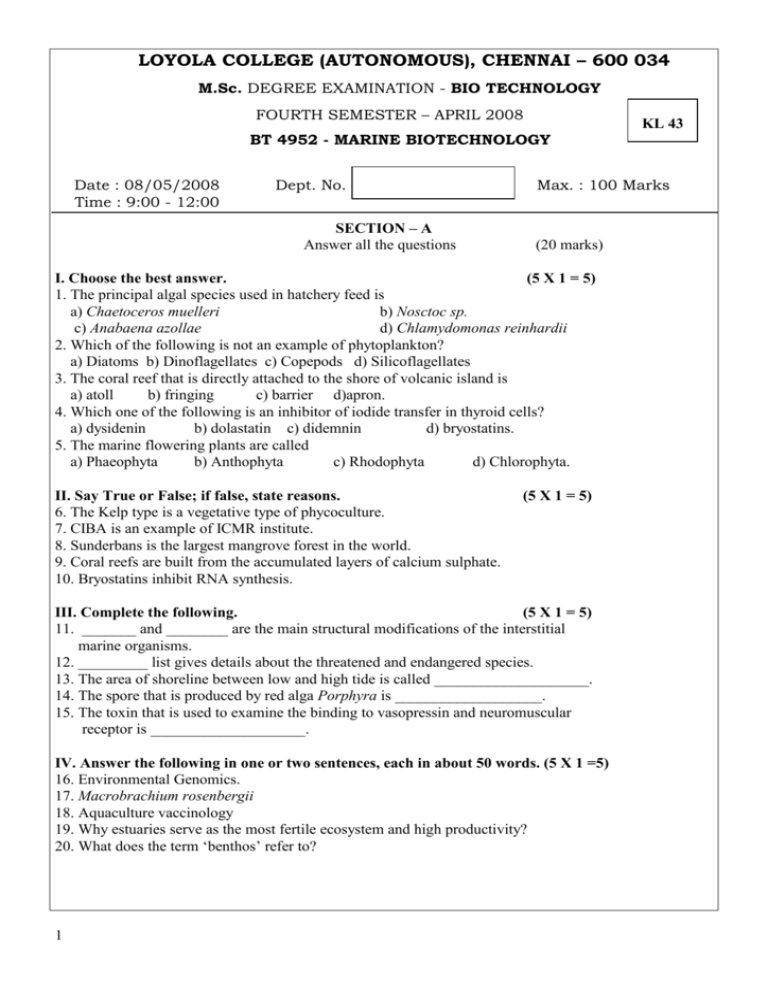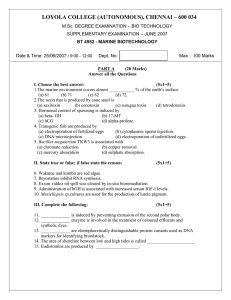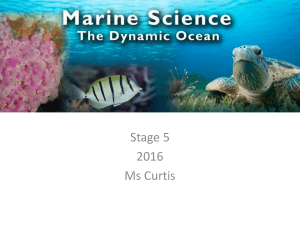BT 4952 - Loyola College
advertisement

LOYOLA COLLEGE (AUTONOMOUS), CHENNAI – 600 034 M.Sc. DEGREE EXAMINATION - BIO TECHNOLOGY FOURTH SEMESTER – APRIL 2008 KL 43 BT 4952 - MARINE BIOTECHNOLOGY Date : 08/05/2008 Time : 9:00 - 12:00 Dept. No. SECTION – A Answer all the questions Max. : 100 Marks (20 marks) I. Choose the best answer. (5 X 1 = 5) 1. The principal algal species used in hatchery feed is a) Chaetoceros muelleri b) Nosctoc sp. c) Anabaena azollae d) Chlamydomonas reinhardii 2. Which of the following is not an example of phytoplankton? a) Diatoms b) Dinoflagellates c) Copepods d) Silicoflagellates 3. The coral reef that is directly attached to the shore of volcanic island is a) atoll b) fringing c) barrier d)apron. 4. Which one of the following is an inhibitor of iodide transfer in thyroid cells? a) dysidenin b) dolastatin c) didemnin d) bryostatins. 5. The marine flowering plants are called a) Phaeophyta b) Anthophyta c) Rhodophyta d) Chlorophyta. II. Say True or False; if false, state reasons. 6. The Kelp type is a vegetative type of phycoculture. 7. CIBA is an example of ICMR institute. 8. Sunderbans is the largest mangrove forest in the world. 9. Coral reefs are built from the accumulated layers of calcium sulphate. 10. Bryostatins inhibit RNA synthesis. (5 X 1 = 5) III. Complete the following. (5 X 1 = 5) 11. _______ and ________ are the main structural modifications of the interstitial marine organisms. 12. _________ list gives details about the threatened and endangered species. 13. The area of shoreline between low and high tide is called ____________________. 14. The spore that is produced by red alga Porphyra is ___________________. 15. The toxin that is used to examine the binding to vasopressin and neuromuscular receptor is ____________________. IV. Answer the following in one or two sentences, each in about 50 words. (5 X 1 =5) 16. Environmental Genomics. 17. Macrobrachium rosenbergii 18. Aquaculture vaccinology 19. Why estuaries serve as the most fertile ecosystem and high productivity? 20. What does the term ‘benthos’ refer to? 1 SECTION – B V. Answer any five questions, each in about 350 words only. (5 X 8 = 40) 21. What are the various applications of PCR in aquaculture? 22. Comment on the production of Single Cell Proteins from sea weeds, and their medicinal importance. 23. (i) Give the importance of hatchery feed in the production of shrimp. (ii) Explain the life-cycle of giant tiger shrimp. 24. How are the shellfish and finfish species exploited biotechnologically for the production of enzymes, hormones and immunoactive peptides? 25. Why mangrove ecosystems are considered as the objects of conservation programs? 26. Explain the use of genetically engineered bacteria in removing oil spills. 27. Outline the general classification of aquatic ecosystem. 28. Give an account on the algal natural products. SECTION – C VI. Answer the following, each in about 1500 words. (2 x 20 = 40) 29. a) What are the various parameters in Oceanography that have to be exploited for a sustainable aquaculture practice? Also, mention about the abiotic and biotic factors influencing marine organism production? (10 + 6 +4). (or) b) ‘The growth of marine agronomy in the 21st century has contributed significantly to the field of medicine and economic development’ – Justify this statement with appropriate examples. 30. a) Explain the marine biofouling cycle and their significance. Add a note on antifouling agents. (or) b) Explain the potential applications of marine bioresources in medicine, and write about the production of biopolymers and bioluminant products with suitable examples and uses. **************** 2











